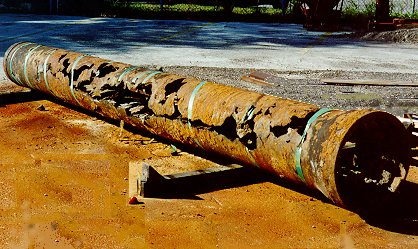 Justin is currently serving as Director of Field Services at KGC where he oversees all field personnel and projects. Justin has served in this role for 5 years and has been part of several multi-million dollar infrastructure projects. Justin also assists in marketing and business development for KGC. Justin holds a Master of Business Administration degree from McNeese State University. Justin is a Certified Project Management Professional (PMP), NACE Level 2 Certified Coating Inspector and SSPC C3 Competent Person.
Justin is currently serving as Director of Field Services at KGC where he oversees all field personnel and projects. Justin has served in this role for 5 years and has been part of several multi-million dollar infrastructure projects. Justin also assists in marketing and business development for KGC. Justin holds a Master of Business Administration degree from McNeese State University. Justin is a Certified Project Management Professional (PMP), NACE Level 2 Certified Coating Inspector and SSPC C3 Competent Person. What is Missing From Your Infrastructure Asset Management Plan?
Owners and managers of our nation’s aging infrastructure are faced with several challenges. They must analyze and assess the condition of various assets and determine if they should repair, rehabilitate, replace or monitor. The decisions made are often a reflection of budgetary constraints, duration of asset downtime and projected length of asset life. All infrastructure owners would love to pour money into repairs and replacements, but the reality is they are operating with finite resources and time. The development and implementation of an asset maintenance program will assist owners in extending the useful life of their assets. The following items are critical to a comprehensive asset maintenance program.
1. Create an Asset Database
This is a tedious, but a necessary element, to any asset maintenance program. Before making any maintenance decisions, owners need to know what assets they have, where the assets are located and what condition are they in. This process involves performing inspections, gathering plans and blueprints, reviewing past maintenance records and entering data into spreadsheets. The cost associated with this process is substantial, but it is important to have a solid foundation of information to aid in making maintenance decisions.
2. Repair, Rehabilitate, Replace or Monitor
Each asset should be grouped into a category based on its condition upon inspection. The following chart may be utilized for grouping purposes.
| Asset Condition Grade | ||
| Rank | Grade | Description of Condition |
| 1 | Very Good | Sound structure, very good condition, only normal/routine maintenance required |
| 2 | Good | Functionally sound structure, minor defects only minor maintenance required (5% of asset would require replacement) |
| 3 | Moderate | Adequate structure, minor cracking/damage, significant maintenance required to return to accepted level of service (10-20% of the asset would require replacement) |
| 4 | Poor | Structure functioning but with problems, significant renewal/upgrade required (20-40% of the asset would require replacement) |
| 5 | Very Poor | Structure has serious problems, asset unserviceable (over 50% of asset requires replacement) |
Chart courtesy of Tony Rojas and Jim H. Davis.[1]
Once the assets are grouped by condition a prioritized list of repair/maintenance projects can be developed. Things to consider when prioritizing projects are current budget, asset downtime, availability of material & manpower, accessibility, associated risks and the potential increase in service life. The decision to repair, rehabilitate or replace may be based on one or a combination of the aforementioned items.
3. Utilize Project Management Principles
There are 5 different phases of project management: Initiating, Planning, Executing, Monitoring and Controlling and Closing.
The initiating phase includes developing a project charter, consulting with various stakeholders and performing high-level risk assessments. The ability to interact and discuss projects with stakeholders will often uncover hidden risks, costs and concerns.
Most project management professionals agree that the planning phase is the most important step in the project management process. During this phase, the project manager develops a schedule, refines the budget, refines the scope, performs risk assessments and organizes other project elements. According to Davis and Rojas (2017), effective project planning provides quicker repairs, better quality repairs, more efficient “wrench time”, improved parts and materials usage, improved safety on the job and less downtime of systems and equipment.
Project execution involves the implementation of the plan developed in planning phase to produce an agreed upon deliverable. A well-thought-out specification can greatly assist the maintenance personnel or outside contractor in producing the final deliverable.
Monitoring and Controlling is an ongoing process that takes place for the duration of the project. During this phase, the project manager ensures that project is staying on time, on budget and within scope. It is not uncommon for asset owners to hire outside consultants or inspectors to perform third-party inspection during maintenance projects. Third-party inspection provides asset owners with the piece of mind, ensuring that repairs were made according to the project management plan and project specification.
The closing phase of the project involves completing any punch list items, creating a lessons learned document and producing a final project report detailing successes and failures of the project. Many repairs or maintenance activities are reoccurring. Having a detailed account of all lessons learned can assist future project managers and asset owners when a similar project is being considered.
4. Update Asset Database
Upon completion of each maintenance project, the asset database should be updated to reflect the final cost of the repair, duration of the project, asset downtime, new asset life expectancy and any other useful information. A routine inspection and maintenance schedule should be developed and assigned to the maintenance department. The accounting department should update the budget to reflect the final project cost. Successful project completion should also be communicated to stakeholders and end-users.
The development and implementation of an asset maintenance program will promote organization, efficiency and longevity for asset owners. A sound asset maintenance program will transform your asset management from a reactive approach to a proactive approach. While the initial costs may be high, the future savings, reduced asset downtime and extended asset life will benefit all stakeholders.
[1] Davis, J. H., & Rojas, T. (2017). Fundamentals of a Sound Asset Maintenance Management Strategy.
Retrieved from http://www.waterworld.com/articles/print/volume-24/issue-5/editorial-feature/fundamentals-of-a-sound-asset-maintenance-management-strategy.html

